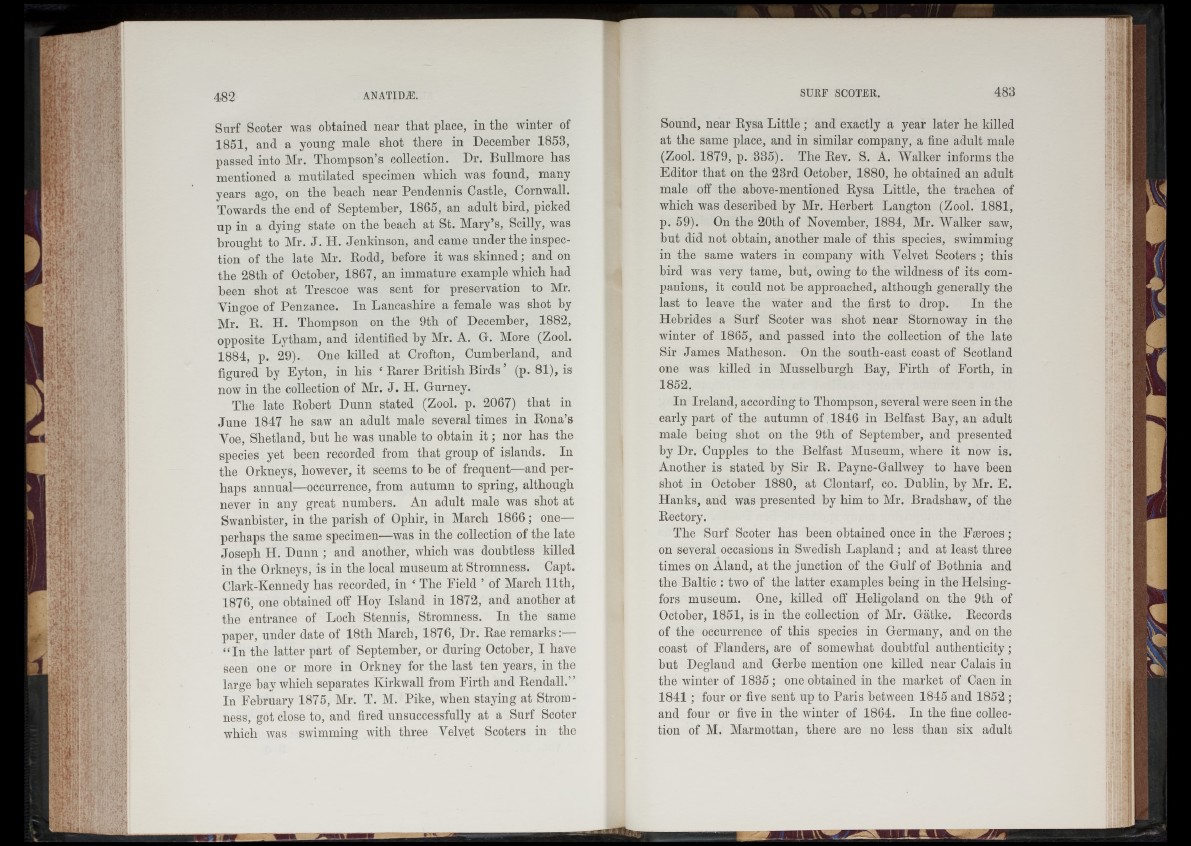
Surf Scoter was obtained near that place, in the winter of
1851, and a young male shot there in December 1853,
passed into Mr. Thompson’s collection. Dr. Bullmore has
mentioned a mutilated specimen which was found, many
years ago, on the beach near Pendennis Castle, Cornwall.
Towards the end of September, 1865, an adult bird, picked
up in a dying state on the beach at St. Mary’s, Scilly, was
brought to Mr. J. H. Jenkinson, and came under the inspection
of the late Mr. Rodd, before it was skinned; and on
the 28th of October, 1867, an immature example which had
been shot at Trescoe was sent for preservation to Mr.
Vingoe of Penzance. In Lancashire a female was shot by
Mr. R. H. Thompson on the 9th of December, 1882,
opposite Lytham, and identified by Mr. A. G-. More (Zool.
1884, p. 29). One killed at Crofton, Cumberland, and
figured by Eyton, in his ‘ Rarer British Birds ’ (p. 81), is
now in the collection of Mr. J. H. Gurney.
The late Robert Dunn stated (Zool. p. 2067) that in
June 1847 he saw an adult male several times in Rona’s
Yoe, Shetland, but he was unable to obtain i t ; nor has the
species yet been recorded from that group of islands. In
the Orkneys, however, it seems to he of frequent—and perhaps
annual—occurrence, from autumn to spring, although
never in any great numbers. An adult male was shot at
Swanbister, in the parish of Opliir, in March 1866; one—
perhaps the same specimen—was in the collection of the late
Joseph H. Dunn ; and another, which was doubtless killed
in the Orkneys, is in the local museum at Stromness. Capt.
Clark-Kennedy has recorded, in ‘ The Field ’ of March 11th,
1876, one obtained off Hoy Island in 1872, and another at
the entrance of Loch Stennis, Stromness. In the same
paper, under date of 18th March, 1876, Dr. Rae remarks:—
“ In the latter part of September, or during October, I have
seen one or more in Orkney for the last ten years, in the
large bay which separates Kirkwall from Firth and Rendall.”
In February 1875, Mr. T. M. Pike, when staying at Stromness,
got close to, and fired unsuccessfully at a Surf Scoter
which was swimming with three Velvet Scoters in the
Sound, near Rysa Little ; and exactly a year later he killed
at the same place, and in similar company, a fine adult male
(Zool. 1879, p. 335). The Rev. S. A. Walker informs the
Editor that on the 23rd October, 1880, he obtained an adult
male off the above-mentioned Rysa Little, the trachea of
which was described by Mr. Herbert Langton (Zool. 1881,
p. 59). On the 20tli of November, 1884, Mr. Walker saw,
but did not obtain, another male of this species, swimming
in the same waters in company with Velvet Scoters ; this
bird was very tame, but, owing to the wildness of its companions,
it could not be approached, although generally the
last to leave the water and the first to drop. In the
Hebrides a Surf Scoter was shot near Stornoway in the
winter of 1865, and passed into the collection of the late
Sir James Matheson. On the south-east coast of Scotland
one was killed in Musselburgh Bay, Firth of Forth, in
1852.
In Ireland, according to Thompson, several were seen in the
early part of the autumn of 1846 in Belfast Bay, an adult
male being shot on the 9th of September, and presented
by Dr. Cupples to the Belfast Museum, where it now is.
Another is stated by Sir R. Payne-Gallwey to have been
shot in October 1880, at Clontarf, co. Dublin, by Mr. E.
Hanks, and was presented by him to Mr. Bradshaw, of the
Rectory.
The Surf Scoter has been obtained once in the Faeroes ;
on several occasions in Swedish Lapland ; and at least three
times on Aland, at the junction of the Gulf of Bothnia and
the Baltic : two of the latter examples being in the Helsingfors
museum. One, killed off Heligoland on the 9tli of
October, 1851, is in the collection of Mr. Gatke. Records
of the occurrence of this species in Germany, and on the
coast of Flanders, are of somewhat doubtful authenticity ;
but Degland and Gerbe mention one killed near Calais in
the winter of 1835 ; one obtained in the market of Caen in
1841 ; four or five sent up to Paris between 1845 and 1852 ;
and four or five in the winter of 1864. In the fine collection
of M. Marmottan, there are no less than six adult